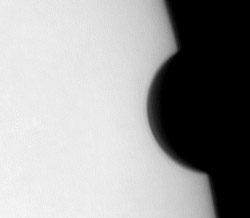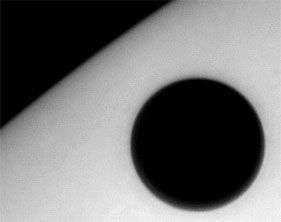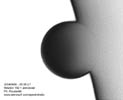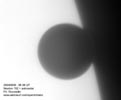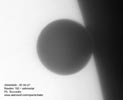|
Instruments
Newtonian Telescope 192/950 mm on equatorial mount.
Astrosolar d5 filter -> 185 mm aperture.
Visual observation :
- Eyepieces SP-4000 6.4, 9.7, 15 et 20 mm
Video Sequences :
- webcam toucam pro standard - Focal length 5.25 m (amplification by eyepiece
SP-4000 12.4 mm) - video capture with Qcfocus software
Photography :
- Zenit 12XP camera - focal length 950 and 1900 (2x amplifier) - fuji film
100 iso
Monochromatic imaging :
- Spectroheliograph (H-alpha, calcium II)
Localisation, weather
Metz, France - (49° 5' N & 6° 11' E)
Very good weather when starting observations
(no wind, clear sky, but Sun very low). few degradation in the morning caused
by high clouds in height and irregular wind.
Observation of contacts
The first contact was observed
visually and estimated at 05:20:06
UT
The progress of Venus in front of the solar disk was then filmed with the webcam
from 05:26:30s UT at the rate of 1 "AVI" of 30 seconds every minutes during
30 minutes. An animation allows to reconstitute
a speeded-up movement.
|
Capture :
- Black and white , Gain = 25 %
- Exp. 1/500 s
- 10 images/s
"AVI" processing with Registax2
:
- keep 200 images/viewe
- Wavelets 5,20,5,1,1,1
- Histogram adjustment
|
|
Determination of the instant of second contact from the video 05:39:30
- 05:40:00 UT.
Groups of 10 images, chosen among the least deformed by the turbulence
and framing the moment of 2nd contact, were separately handled to obtain
this sequence. The hour mentioned under each view is the arithmetic
average of 10 moments corresponding to the images of each group.
Instant of second
contact is estimated at 05:39:45
UT
|
The end of the transit was also followed with
the webcam, from 10:54:00s UT at the rate of 1 "AVI" of 30 seconds
every minutes during 30 minutes except for the last one
who lasted 1 minute. The presence of wind and the nearness of roofs
warmed by the solar radiation strongly increased the
turbulence. An animation allows to reconstitute
this speeded-up movement. |
| |
Capture :
- Black and white , Gain = 25 %
- Exp. 1/500 s
- 10 images/s
"AVI" processing with Registax2 :
- keep 200 images/viewe
- Wavelets 5,20,5,1,1,1
- Histogram adjustment
|
Determination
of the instant of third contact from the video 11:04:00
- 11:04:30 UT
(Same method than second contact).

Instant of third
contact is estimated at 11:04:09
UT
Determination
of the instant of 4th contact from video 11:23:00
- 11:24:00 UT
Instant of fourth
contact is estimated at 11:23:36
UT
|
|
Few
images extracted from the video of the begining of the transit show
a brilliant arc resulting from the illumination of the atmosphere of Venus by solar light.
|
|
Capture of monochromatic images was done with
the spectroheliograph. We can note the poor solar activity.
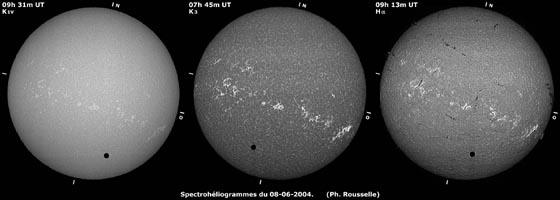
|
|
Very small sunspots was visible near the center
of the disc. 2 groups have been filmed with the
webcam (NOAA 0627
et NOAA 0628) and are visible at the page "archives 2004".
|
|
Images
taken with film will be inserted later. |
| |
Conclusions
The observation of this phenomenon took place
in a almost optimal way and allowed me to estimate the moments of
4 contacts. The examination - image by image - of films show that
the turbulence causes distortions which, in the approach of the
internal contacts, thicken, thin or remove the narrow strand of
light between the edge of the Sun and that of Venus.
It is thus very likely that this type of observation gives a result
soiled by an error of several seconds. The sending of
4 instants of contact to the calculation interface of the IMCCE
gives a value of the Astronomical Unit rather good :
|
Instants (UTC) |
AU (km) |
parallax ('') |
dev. AU (km) |
dev. parallax ('') |
Error |
|
| 1 |
05 h 20 m 06 s |
149617004 |
8.7930 |
19134 |
0.0011 |
0.013 % |
| 2 |
05 h 39 m 45 s |
149607657 |
8.7936 |
9787 |
0.0006 |
0.007 % |
| 3 |
11 h 04 m 09 s |
149604291 |
8.7938 |
6421 |
0.0004 |
0.004 % |
| 4 |
11 h 23 m 36 s |
149534474 |
8.7979 |
63396 |
0.0037 |
0.042 % |
|
|
|
|
|
|
|
|
|
AU av. = 149590856 km |
|
| |
|
parallax av. = 8.7946 '' |
|
| |
|
Error av. = 0.005 % |
|
The discovery on my images of the atmospheric
arc of Venus was also a moment of surprise and lively interest.
The phenomenon of "black drop" was not recorded.
It is certainly connected to a strong turbulence and\or to
an instrumental cause.
The diverse shots were obviously interrupted
with visual observations. What I imagined to be a small black
disk walking on a big brilliant disk showed in fact to be a surprising
spectacle : the vision of a planet orbiting around
its star.
Finally, and although that is not a real surprise,
the precision of the forecasts in celestial mechanics is always so
surprising. |
|

 )
) )
)


